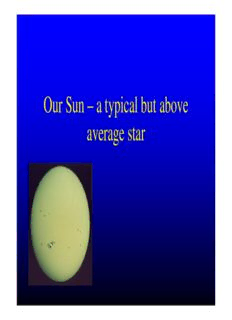
Our Sun – a typical but above average star PDF
Preview Our Sun – a typical but above average star
Our Sun – a typical but above average star Relative Abundances of the Stellar Types Type Colour Proportion • 0 Blue 0.003% • B Blue-white 0.13% • A White 0.63% • F White-yellow 3.1% • G Yellow 8% • K Orange 13% • M Red 78% Our Sun is a type G2 • The sun is towards the hotter end of the G- type stars; ~3% are hotter and more massive, so ~5% cooler and less massive. • So ~ (5+13+78)% = ~96% are cooler and less massive. • Only 4% of stars are hotter and more massive • Ours is quite an up market star! Size of the Sun The Sun subtends an angular size of ~ 0.5 degrees. Its mean distance from the Earth is 1.49 x 10 11 m q Diameter = r x = 1.49 x 10 11 m x 0.5/ 57.3 = 1.3 x 10 9 m The precise value is 1,391,978 km Mass of the Sun Mass - Derive from orbit of Earth: MmG/r2 = m v2/r (M = mass Sun, m = mass Earth) M = v2r/ G p But v = 2 r/P where P is the period of the Earth’s orbit, so substituting, M = 4 p 2 r3/ GP2 Units: kg, seconds, m = 2 X 1030 kg (Try this evaluation!) The Solar Constant How much energy falls per square metre on the “surface” of the Earth at the sub solar point in Watts? The Solar Constant The Solar Constant is the amount of energy that passes through each square metre of space at the average distance of the Earth It is 1368 watts/sq metre Energy Output of the Sun • Given the Sun is at a distance of 1.5 x 1011 metres you can calculate the total surface area of a shell at the Earth’s average distance and, by multiplying this by the Solar Constant, calculate the total energy output of the Sun.
Description: